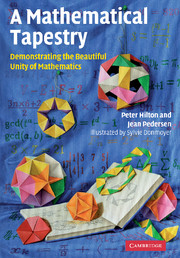Book contents
- Frontmatter
- Contents
- Preface
- Acknowledgments
- 1 Flexagons – A beginning thread
- 2 Another thread – 1-period paper-folding
- 3 More paper-folding threads – 2-period paper-folding
- 4 A number-theory thread – Folding numbers, a number trick, and some tidbits
- 5 The polyhedron thread – Building some polyhedra and defining a regular polyhedron
- 6 Constructing dipyramids and rotating rings from straight strips of triangles
- 7 Continuing the paper-folding and number-theory threads
- 8 A geometry and algebra thread – Constructing, and using, Jennifer's puzzle
- 9 A polyhedral geometry thread – Constructing braided Platonic solids and other woven polyhedra
- 10 Combinatorial and symmetry threads
- 11 Some golden threads – Constructing more dodecahedra
- 12 More combinatorial threads – Collapsoids
- 13 Group theory – The faces of the trihexaflexagon
- 14 Combinatorial and group-theoretical threads – Extended face planes of the Platonic solids
- 15 A historical thread – Involving the Euler characteristic, Descartes' total angular defect, and Pólya's dream
- 16 Tying some loose ends together – Symmetry, group theory, homologues, and the Pólya enumeration theorem
- 17 Returning to the number-theory thread – Generalized quasi-order and coach theorems
- References
- Index
17 - Returning to the number-theory thread – Generalized quasi-order and coach theorems
Published online by Cambridge University Press: 10 November 2010
- Frontmatter
- Contents
- Preface
- Acknowledgments
- 1 Flexagons – A beginning thread
- 2 Another thread – 1-period paper-folding
- 3 More paper-folding threads – 2-period paper-folding
- 4 A number-theory thread – Folding numbers, a number trick, and some tidbits
- 5 The polyhedron thread – Building some polyhedra and defining a regular polyhedron
- 6 Constructing dipyramids and rotating rings from straight strips of triangles
- 7 Continuing the paper-folding and number-theory threads
- 8 A geometry and algebra thread – Constructing, and using, Jennifer's puzzle
- 9 A polyhedral geometry thread – Constructing braided Platonic solids and other woven polyhedra
- 10 Combinatorial and symmetry threads
- 11 Some golden threads – Constructing more dodecahedra
- 12 More combinatorial threads – Collapsoids
- 13 Group theory – The faces of the trihexaflexagon
- 14 Combinatorial and group-theoretical threads – Extended face planes of the Platonic solids
- 15 A historical thread – Involving the Euler characteristic, Descartes' total angular defect, and Pólya's dream
- 16 Tying some loose ends together – Symmetry, group theory, homologues, and the Pólya enumeration theorem
- 17 Returning to the number-theory thread – Generalized quasi-order and coach theorems
- References
- Index
Summary
Setting the stage
In Chapter 7 we explicitly stated, and proved, the quasi-order theorem in base 2 and stated it in base 3, giving examples. We will carry this thread further in Section 17.2 and show how, in base 2, it leads to what we call the coach theorem. Having come this far it is natural to ask if the quasi-order theorem and the coach theorem can be generalized. The answer is “yes” and we carry out the details in Sections 17.3 and 17.4.
Sections 17.5 and 17.6 grew out of the interest shown by two students, Victor Quintanar-Zilinskas and Linda Velarde, in work done by the authors and Byron Walden. After taking a course from one of the authors (JP), Victor and Linda asked if they could continue “looking for patterns” in the complete coaches in base t (as explained below), during a summer research project at Santa Clara University. Permission was readily granted, and Sections 17.5 and 17.6 chronicle their discoveries (which were published in [44]).
Although it is important to be able to create the complete symbols for oneself, it greatly facilitates looking for patterns to have a large amount of data available. So, at the beginning of the summer research project, Byron Walden wrote a Maple program that generates the desired data. Those of you interested in studying the complete symbols may wish to write your own program to obtain such data.
- Type
- Chapter
- Information
- A Mathematical TapestryDemonstrating the Beautiful Unity of Mathematics, pp. 260 - 281Publisher: Cambridge University PressPrint publication year: 2010



